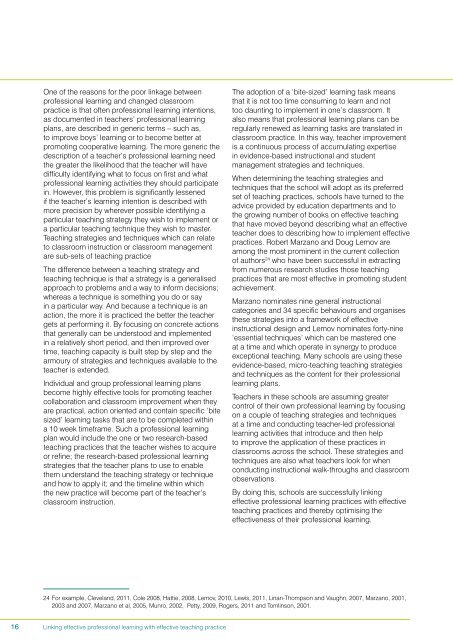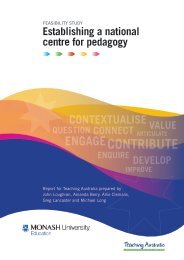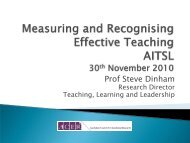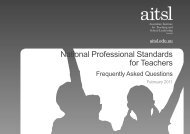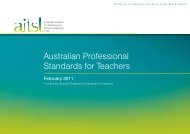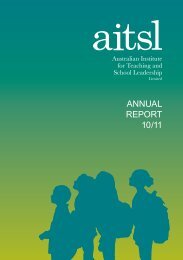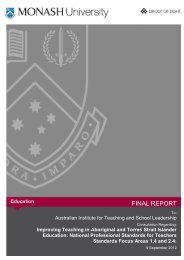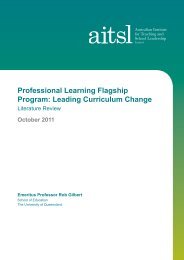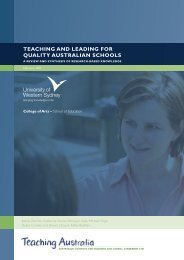Linking effective professional learning with effective teaching practice
Linking effective professional learning with effective teaching practice
Linking effective professional learning with effective teaching practice
Create successful ePaper yourself
Turn your PDF publications into a flip-book with our unique Google optimized e-Paper software.
One of the reasons for the poor linkage between<strong>professional</strong> <strong>learning</strong> and changed classroom<strong>practice</strong> is that often <strong>professional</strong> <strong>learning</strong> intentions,as documented in teachers’ <strong>professional</strong> <strong>learning</strong>plans, are described in generic terms – such as,to improve boys’ <strong>learning</strong> or to become better atpromoting cooperative <strong>learning</strong>. The more generic thedescription of a teacher’s <strong>professional</strong> <strong>learning</strong> needthe greater the likelihood that the teacher will havedifficulty identifying what to focus on first and what<strong>professional</strong> <strong>learning</strong> activities they should participatein. However, this problem is significantly lessenedif the teacher’s <strong>learning</strong> intention is described <strong>with</strong>more precision by wherever possible identifying aparticular <strong>teaching</strong> strategy they wish to implement ora particular <strong>teaching</strong> technique they wish to master.Teaching strategies and techniques which can relateto classroom instruction or classroom managementare sub-sets of <strong>teaching</strong> <strong>practice</strong>The difference between a <strong>teaching</strong> strategy and<strong>teaching</strong> technique is that a strategy is a generalisedapproach to problems and a way to inform decisions;whereas a technique is something you do or sayin a particular way. And because a technique is anaction, the more it is <strong>practice</strong>d the better the teachergets at performing it. By focusing on concrete actionsthat generally can be understood and implementedin a relatively short period, and then improved overtime, <strong>teaching</strong> capacity is built step by step and thearmoury of strategies and techniques available to theteacher is extended.Individual and group <strong>professional</strong> <strong>learning</strong> plansbecome highly <strong>effective</strong> tools for promoting teachercollaboration and classroom improvement when theyare practical, action oriented and contain specific ‘bitesized’ <strong>learning</strong> tasks that are to be completed <strong>with</strong>ina 10 week timeframe. Such a <strong>professional</strong> <strong>learning</strong>plan would include the one or two research-based<strong>teaching</strong> <strong>practice</strong>s that the teacher wishes to acquireor refine; the research-based <strong>professional</strong> <strong>learning</strong>strategies that the teacher plans to use to enablethem understand the <strong>teaching</strong> strategy or techniqueand how to apply it; and the timeline <strong>with</strong>in whichthe new <strong>practice</strong> will become part of the teacher’sclassroom instruction.The adoption of a ‘bite-sized’ <strong>learning</strong> task meansthat it is not too time consuming to learn and nottoo daunting to implement in one’s classroom. Italso means that <strong>professional</strong> <strong>learning</strong> plans can beregularly renewed as <strong>learning</strong> tasks are translated inclassroom <strong>practice</strong>. In this way, teacher improvementis a continuous process of accumulating expertisein evidence-based instructional and studentmanagement strategies and techniques.When determining the <strong>teaching</strong> strategies andtechniques that the school will adopt as its preferredset of <strong>teaching</strong> <strong>practice</strong>s, schools have turned to theadvice provided by education departments and tothe growing number of books on <strong>effective</strong> <strong>teaching</strong>that have moved beyond describing what an <strong>effective</strong>teacher does to describing how to implement <strong>effective</strong><strong>practice</strong>s. Robert Marzano and Doug Lemov areamong the most prominent in the current collectionof authors 24 who have been successful in extractingfrom numerous research studies those <strong>teaching</strong><strong>practice</strong>s that are most <strong>effective</strong> in promoting studentachievement.Marzano nominates nine general instructionalcategories and 34 specific behaviours and organisesthese strategies into a framework of <strong>effective</strong>instructional design and Lemov nominates forty-nine‘essential techniques’ which can be mastered oneat a time and which operate in synergy to produceexceptional <strong>teaching</strong>. Many schools are using theseevidence-based, micro-<strong>teaching</strong> <strong>teaching</strong> strategiesand techniques as the content for their <strong>professional</strong><strong>learning</strong> plans.Teachers in these schools are assuming greatercontrol of their own <strong>professional</strong> <strong>learning</strong> by focusingon a couple of <strong>teaching</strong> strategies and techniquesat a time and conducting teacher-led <strong>professional</strong><strong>learning</strong> activities that introduce and then helpto improve the application of these <strong>practice</strong>s inclassrooms across the school. These strategies andtechniques are also what teachers look for whenconducting instructional walk-throughs and classroomobservations.By doing this, schools are successfully linking<strong>effective</strong> <strong>professional</strong> <strong>learning</strong> <strong>practice</strong>s <strong>with</strong> <strong>effective</strong><strong>teaching</strong> <strong>practice</strong>s and thereby optimising the<strong>effective</strong>ness of their <strong>professional</strong> <strong>learning</strong>.24 For example, Cleveland, 2011, Cole 2008, Hattie, 2008, Lemov, 2010, Lewis, 2011, Linan-Thompson and Vaughn, 2007, Marzano, 2001,2003 and 2007, Marzano et al, 2005, Munro, 2002, Petty, 2009, Rogers, 2011 and Tomlinson, 2001.16 <strong>Linking</strong> <strong>effective</strong> <strong>professional</strong> <strong>learning</strong> <strong>with</strong> <strong>effective</strong> <strong>teaching</strong> <strong>practice</strong>


